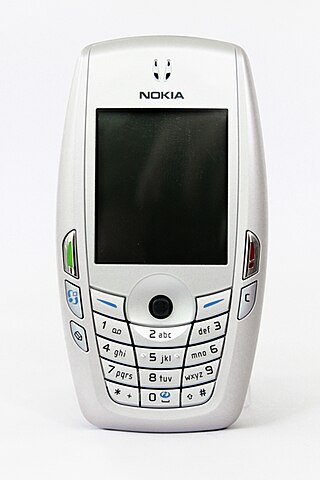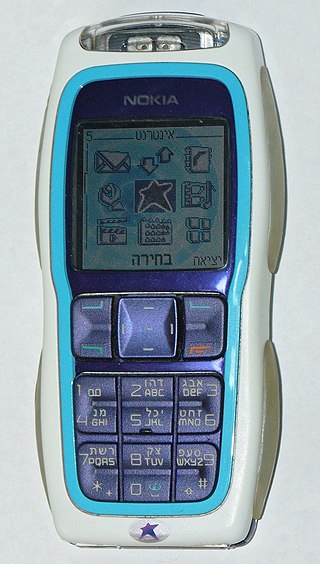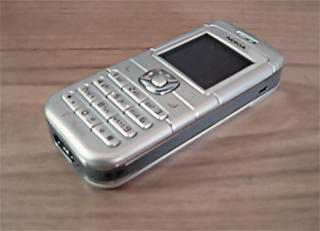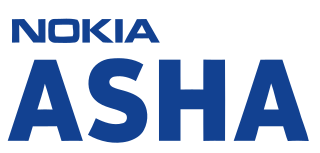
The 6620 is a smartphone created by Nokia, announced in 2004, running on Series 60 2nd Edition and the Symbian operating system. It was the first EDGE-capable phone for the Americas' market.

The Nokia 6230 is a mobile phone based on the Nokia Series 40 platform. It was announced on 28 October 2003 and released in February 2004.

The Nokia 6600 is a smartphone introduced on June 16, 2003 by Nokia, costing approximately €600 when released in October 2003. It was Nokia's high-end model of the 6xxx Classic Business Series. At the time of release, it was the most advanced product ever launched by Nokia, and it runs on Symbian OS 7.0s. It also featured a VGA camera, a music player and video player, Bluetooth and extended storage by memory card, being the second non-Communicator to do so.

The Nokia 3200 is a mobile phone by Nokia, part of the Nokia Expression (youth) series and announced on 12 September 2003. It is based on the Nokia Series 40 platform. The phone is an update of the Nokia 3100, while adding features from the Nokia 7250i and 6610i. The phone's feature set was very similar to the 7250i and 6610i, but featured different software and firmware installed, and was sold at a lower price than the 7250i or 6610i. Of the three phones, the 3200 was mainly targeted towards the youth market, the 7250i towards fashion-conscious users, and the 6610i towards business users. Core features include an XHTML browser, alarm clock, flashlight, EDGE and FM stereo radio with a 128 × 128 12-bit (4096) color screen. The phone has multimedia features such as picture and text messaging. Features carried over from the Nokia 3100 include ringer profiles and voice memo capability. It also has Java games. The phone has an extensive calendar with a lunar calendar. The flashlight is located under the phone and can be activated by holding the "star" (asterisk) key. The camera is on the back of the phone. The 3200 can also play both polyphonic and monophonic ringtones. The phone's visual interface in its menu system is similar to that of the Nokia 3100, using large, static icons rather than animated ones.

The Nokia 3220 is a GSM, Series 40 mobile phone from Nokia. The Nokia 3220 was introduced on 31 May 2004 as a "fun" device with LED lights and Xpress-on covers. It was the first entry-level phone that offered full access to the Internet, with an XHTML browser and POP3/IMAP email client. The tri-band camera phone uses GPRS and EDGE for its internet connections.

The features of mobile phones are the set of capabilities, services and applications that they offer to their users. Mobile phones are often referred to as feature phones, and offer basic telephony. Handsets with more advanced computing ability through the use of native code try to differentiate their own products by implementing additional functions to make them more attractive to consumers. This has led to great innovation in mobile phone development over the past 20 years.
The Nokia 6131/Nokia 6133 is a Nokia clamshell phone introduced by Nokia in February 2006.

The Nokia 6030, introduced in Q1 2005, is a GSM dual band handset operating on frequencies 900 and 1800 MHz, with automatic switching between frequencies. It is small in size with dimensions of 104 x 44 x 18 mm and weighs 90 grams. It also has 3MB Shared Memory.

The Nokia 6020 and 6021 are feature phones made by Nokia, running the Series 40 platform. The Nokia 6020 has a camera and no Bluetooth support, while the Nokia 6021 has Bluetooth and does not have a camera. The Nokia 6020 was introduced in November 2004 as a successor of the Nokia 6010 for Americas and the Nokia 3510i and also the Nokia 6230 for the global market. It was succeeded by the Nokia 6070 in 2006.

The Nokia 6110 Navigator is a smartphone made by Nokia, announced on 12 February 2007. It has been available since June 2007. It runs on Symbian OS v9.2 with a S60 3rd Edition FP1 user interface. It is not to be confused with the 1997/98 Nokia 6110. The Nokia 6110 Navigator includes pre-loaded navigation maps.
The Nokia 6000 series or Classic Business series is range of mobile phones marketed by Nokia. This family of phones is notable for their conservative, unisex designs, making the family popular with business users.

Nokia 5300 XpressMusic is a slider mobile phone by Nokia, part of the XpressMusic range. It was introduced on 26 September 2006 and released at the end of that year. It runs on Nokia Series 40 3rd Edition FP2.
The Nokia 5070 is a sibling of Nokia 6070 mobile phone made by Nokia. It operates on GSM tri band frequency 900, 1800 and 1900 MHz, with automatic switching between frequencies. It is small in size with dimensions of 105,4 x 44,3 x 18,6 mm and weights 88 grams.
The Nokia 3600 slide is a mobile phone by Nokia that was released in August 2008. The phone runs the Series 40 3rd Edition platform. This is classed as the 'low end version' of the Nokia 6600 slide, its major difference being the lack of 3G support.

The Nokia 2600 classic is a Nokia Dual-band GSM phone E900/1800 or E850/1900 that includes a VGA camera, FM radio, Bluetooth, E-mail and mobile Internet access via a WAP browser. Additionally, the Nokia 2600 supports MMS and Nokia Xpress Audio Messaging, for recording and editing messages on the go. It also had a similar sliding variant called Nokia 2680 slide.
The Nokia 6301, approved by the FCC for the US market in January 2008, is a triband GSM mobile phone. The North American model 6301b is equipped with 850/1800/1900 MHz bands. The European model 6301 is equipped with 900/1800/1900 MHz bands.
The Nokia 6210 Navigator is a smartphone made by Nokia that is a successor to Nokia 6110 Navigator. It was announced on February 11, 2008 and had been available from July 2008. It runs on Symbian OS v9.3 with a S60 3rd Edition FP2 user interface.

The Nokia 2690 is a mobile phone released by Nokia in March 2010. It operates on GSM quad band frequency 850, 900, 1800 and 1900 MHz, with automatic switching between frequencies. It has dimensions of 107.5 × 45.5 × 13.8 mm and weighs 80.7 grams.
The Nokia C6-01 is a Symbian^3 smartphone from the Nokia Cseries. The C6-01 display features comes with a 3.2in AMOLED display with capacitive touchscreen capabilities and Nokia's ClearBlack technology for improved outdoor visibility. The smartphone was released on November 4, 2010 for €260, excluding taxes and subsidies.

The Nokia Asha 310, also known as the Nokia Asha 3010 or the Nokia ASHA 310 RM-911, was released in March 2013. It is the first in the line of the Asha range of phones to have dual subscriber identity module (SIM) slots and Wi-Fi connectivity. It was a reinvention of the Asha range to remain competitive with new Android devices. It cost $102.00 at its launch date. It has a touchscreen, comes with either a 2 or 4 GB micro SD card, and has 64 MB of RAM, a 2 MP camera and a battery that can last up to 600 hours in standby mode. The phone can play music for up to 54 hours or video for up to 9.5 hours, and has a maximum of 17 hours talk time (2G).













